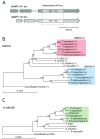A new class of IMP dehydrogenase with a role in self-resistance of mycophenolic acid producing fungi
- PMID: 21923907
- PMCID: PMC3184278
- DOI: 10.1186/1471-2180-11-202
A new class of IMP dehydrogenase with a role in self-resistance of mycophenolic acid producing fungi
Abstract
Background: Many secondary metabolites produced by filamentous fungi have potent biological activities, to which the producer organism must be resistant. An example of pharmaceutical interest is mycophenolic acid (MPA), an immunosuppressant molecule produced by several Penicillium species. The target of MPA is inosine-5'-monophosphate dehydrogenase (IMPDH), which catalyses the rate limiting step in the synthesis of guanine nucleotides. The recent discovery of the MPA biosynthetic gene cluster from Penicillium brevicompactum revealed an extra copy of the IMPDH-encoding gene (mpaF) embedded within the cluster. This finding suggests that the key component of MPA self resistance is likely based on the IMPDH encoded by mpaF.
Results: In accordance with our hypothesis, heterologous expression of mpaF dramatically increased MPA resistance in a model fungus, Aspergillus nidulans, which does not produce MPA. The growth of an A. nidulans strain expressing mpaF was only marginally affected by MPA at concentrations as high as 200 μg/ml. To further substantiate the role of mpaF in MPA resistance, we searched for mpaF orthologs in six MPA producer/non-producer strains from Penicillium subgenus Penicillium. All six strains were found to hold two copies of IMPDH. A cladistic analysis based on the corresponding cDNA sequences revealed a novel group constituting mpaF homologs. Interestingly, a conserved tyrosine residue in the original class of IMPDHs is replaced by a phenylalanine residue in the new IMPDH class.
Conclusions: We identified a novel variant of the IMPDH-encoding gene in six different strains from Penicillium subgenus Penicillium. The novel IMPDH variant from MPA producer P. brevicompactum was shown to confer a high degree of MPA resistance when expressed in a non-producer fungus. Our study provides a basis for understanding the molecular mechanism of MPA resistance and has relevance for biotechnological and pharmaceutical applications.
Figures




Similar articles
-
Adaptive evolution of drug targets in producer and non-producer organisms.Biochem J. 2012 Jan 1;441(1):219-26. doi: 10.1042/BJ20111278. Biochem J. 2012. PMID: 21916847 Free PMC article.
-
A structural determinant of mycophenolic acid resistance in eukaryotic inosine 5'-monophosphate dehydrogenases.Protein Sci. 2020 Mar;29(3):686-694. doi: 10.1002/pro.3766. Epub 2019 Nov 20. Protein Sci. 2020. PMID: 31675145 Free PMC article.
-
Kinetically controlled drug resistance: how Penicillium brevicompactum survives mycophenolic acid.J Biol Chem. 2011 Nov 25;286(47):40595-600. doi: 10.1074/jbc.M111.305235. Epub 2011 Oct 6. J Biol Chem. 2011. PMID: 21979957 Free PMC article.
-
The structure of inosine 5'-monophosphate dehydrogenase and the design of novel inhibitors.Immunopharmacology. 2000 May;47(2-3):163-84. doi: 10.1016/s0162-3109(00)00193-4. Immunopharmacology. 2000. PMID: 10878288 Review.
-
Inosine 5'-monophosphate dehydrogenase activity as a biomarker in the field of transplantation.Clin Chim Acta. 2012 Sep 8;413(17-18):1391-7. doi: 10.1016/j.cca.2011.08.027. Epub 2011 Aug 24. Clin Chim Acta. 2012. PMID: 21889500 Review.
Cited by
-
Tracing the Origin and Evolution of the Fungal Mycophenolic Acid Biosynthesis Pathway.Genome Biol Evol. 2025 Mar 6;17(3):evaf039. doi: 10.1093/gbe/evaf039. Genome Biol Evol. 2025. PMID: 40052422 Free PMC article.
-
Comparison of Strategies to Overcome Drug Resistance: Learning from Various Kingdoms.Molecules. 2018 Jun 18;23(6):1476. doi: 10.3390/molecules23061476. Molecules. 2018. PMID: 29912169 Free PMC article. Review.
-
Fungal Drug Discovery for Chronic Disease: History, New Discoveries and New Approaches.Biomolecules. 2023 Jun 14;13(6):986. doi: 10.3390/biom13060986. Biomolecules. 2023. PMID: 37371566 Free PMC article. Review.
-
Titer improvement of mycophenolic acid in the novel producer strain Penicillium arizonense and expression analysis of its biosynthetic genes.BMC Microbiol. 2023 May 17;23(1):135. doi: 10.1186/s12866-023-02884-z. BMC Microbiol. 2023. PMID: 37198535 Free PMC article.
-
Crossroads of Antibiotic Resistance and Biosynthesis.J Mol Biol. 2019 Aug 23;431(18):3370-3399. doi: 10.1016/j.jmb.2019.06.033. Epub 2019 Jul 6. J Mol Biol. 2019. PMID: 31288031 Free PMC article. Review.
References
-
- Weber G, Nakamura H, Natsumeda Y, Szekeres T, Nagai M. Regulation of GTP biosynthesis. Advances in enzyme regulation. 1992;32:57–69. - PubMed
-
- Frisvad JC, Smedsgaard JR, Larsen TO, Samson RA. Mycotoxins, drugs and other extrolites produced by species in Penicillium subgenus Penicillium. Stud Mycol. 2004;49:201–41.
Publication types
MeSH terms
Substances
Associated data
- Actions
- Actions
- Actions
- Actions
LinkOut - more resources
Full Text Sources

